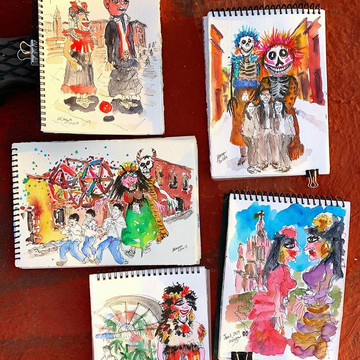One of the best things about being an artist is the path we travel when we learn new skills and try new tools. One would have to exert great effort to remain the same artist today as they were when they began -- the point is to evolve. In doing so, we learn new skills and we learn about ourselves as we go to different places to tell the stories we need to tell. We are the lucky storytellers who have many paths to travel and many tools to explore. With these tools, you can discover what makes you tick and where you are blocked. These revelations were a delightful surprise as I embarked on my artistic journey.
When I reignited my passion for art, I was an adult with a boring but necessary corporate office job, although I was ready to devote time to becoming an artist. I always knew I was an artist, but making time to practice was never a priority, until it became one. I gave myself a drawing challenge instead of taking a class because I wanted to draw every day and had heard this was the best way to increase my chances of developing my drawing skills.
I had to choose a subject…. this stumped me! It had to be something I would easily have access to and began to look around my world. I looked at my phone and then it occurred to me. Twitter! I decided to selectively choose one tweet each day and draw this tweet every day for one year, starting on my birthday. Easy-Peasy I had a subject, so now let’s get to work.

I started with a huge box of French pastels and a large mixed media sketchbook. Each morning I would fire up Twitter and somehow choose a tweet that I would then draw. This proved to be a difficult drawing challenge but nonetheless, I persisted. I had to draw more politicians and celebrities than I was prepared, but I accomplished one entire year of drawing a daily tweet from Twitter -- what an experience! This year-long practice made an incredible difference in my drawing abilities, but once I completed this challenge, I signed off of Twitter and was ready to try new things. The pastels I had been using made quite a mess and they were hard to travel with, so I made the jump to watercolors. I’ll admit I had always been a bit frightened by watercolor, all that scary water pushing the paint around the page! I remember asking myself, “are you really afraid of watercolors? Yes! That water has a mind of its own.”
I didn’t trust watercolor, which now I’ve come to understand that I didn’t know how to work with water. Nor the paper, yet now I’ve discovered it all comes down to a harmonic relationship between the paper, water, pigment, and brushstroke. It’s a medium I continue to work and play with, and I think of it as a dance. Sometimes I’ve got the rhythm in me, and other times I wonder if I should have sat this dance out. All part of the process!
My first attempts at watercolor were much like crayons: I colored in my drawings with cheap watercolor paint. I didn’t use much water with my cheap paints, and I also used cheap paper. My outlook was this: if I wasn’t very good at this medium that I did not trust, I had no reason to invest in quality paints nor paper.
Oh, how wrong I was!

This is the fun part of the journey where we learn about ourselves; I came to understand I had many hard lessons to learn about my self-esteem. Looking back, even though I was a promising and dedicated artist, I just didn’t feel like I was worth quality materials. I made do with cheap paint and I achieved what I thought were good results with sub-par paper. My work has a sketchy, energetic feel, and sometimes the cheap tools worked. Plus, I told myself it was just practice, and also much easier to travel with these lesser products. In hindsight, this makes no sense at all.
As time went on, I eventually started taking watercolor classes because I was curious to learn more. My instructor then became my friend, and she insisted I upgrade my paints and my paper. She gifted me with my first quality palette that she filled with artist-grade paints. She also insisted I work only with a cotton watercolor paper. Wowzah, this was the Big Leagues!
Once I upgraded my paper. I began to understand how to let the water flow with the pigment, and by using a quality 50% cotton blend or 100% cotton paper, I yielded more interesting and dynamic results.

It has only been through trial and error that I’ve discovered which paper has produced the best results for my artwork. I’ve attempted paintings on drugstore paper and sometimes would be happy with the results; I was okay with the fact that the watercolor did not move nor absorb into the paper. Then I would try a painting with true cotton watercolor paper and the results were a million times better, as if by magic or as if I’d never heard the practical science behind why quality paper is better for watercolor efforts.
These days I’m not suggesting I have it all figured out, but I’m enjoying the process of combining watercolor ingredients with different artistic results, which also includes how I see myself in this equation. The more I invest in quality paints, brushes, and paper, the more my appetite increased for wanting to learn more about the dance of watercolor.
It’s yet another layer of being an artist and learning about my relationship with my world and the story of my art. Take the leap and upgrade your materials!
Enjoy the journey.


